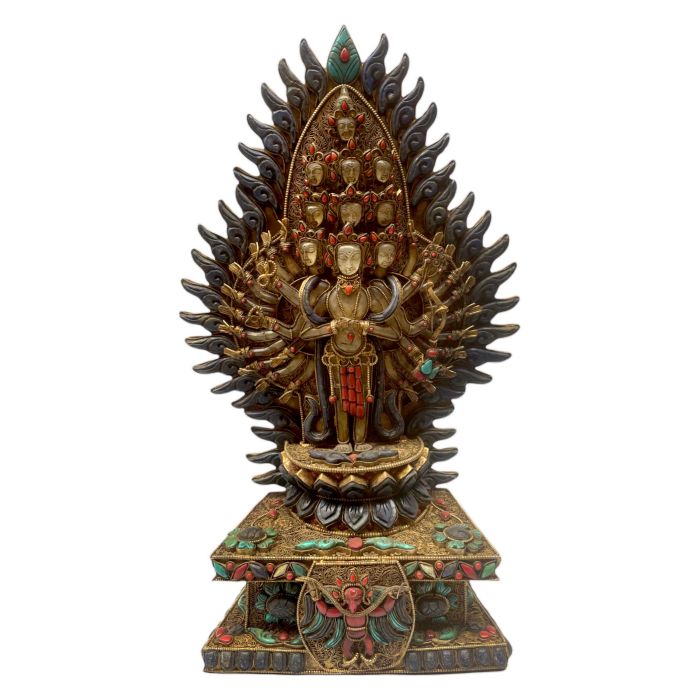☛ Tibetan Statue of Sahasrabhuja Avalokitesvara, Stone Setting, Oxidized
▫ Item Code: HME24724
▫ Weight: 3000 Grams
▫ Size CM : 38 x 23 x 9
▫ Material: Copper
▫ Availability: Available
-----------------------------------------------
☛ TURQUOISE : Brief Introduction
Turquoise is a purification stone. It dispels negative energy and can be worn to protect against outside influences or pollutants in the atmosphere. Turquoise balances and aligns all the chakras, stabilising mood swings and instilling inner calm. It is excellent for depression and exhaustion, it also has the power to prevent panic attacks. Turquoise promotes self-realisation and assists creative problem solving. It is a symbol of friendship, and stimulates romantic love.
☛ LAPIS : Brief Introduction
A stone of protection that may be worn to guard against psychic attacks, Lapis Lazuli quickly releases stress, bringing deep peace. It brings harmony and deep inner self-knowledge. Encourages self-awareness, allows self-expression and reveals inner truth, providing qualities of honesty, compassion and morality to the personality. Stimulates objectivity, clarity and encourages creativity. Lapis Lazuli assists to confront and speak oneâs truth and inspires confidence. It bonds relationships, aiding in expression of feelings and emotions.
☛ CORAL : Brief Introduction
Coral represents diplomacy and concurrence. It quiets the emotions and brings peace to within the self. Facilitates intuition, imagination and visualisation. Coral expedites and accelerates the transfer of knowledge. Coral strengthens the circulatory system and the bones of the body. It stimulates tissue regeneration and nourishes the blood cells. Treats disorders of the spinal canal, the alimentary canal, the nervous system, and the thalamus.
☛ CRYSTAL : Brief Introduction
A crystal or crystalline solid is a solid material whose constituents (such as atoms, molecules, or ions) are arranged in a highly ordered microscopic structure, forming a crystal lattice that extends in all directions.[1][2] In addition, macroscopic single crystals are usually identifiable by their geometrical shape, consisting of flat faces with specific, characteristic orientations. The scientific study of crystals and crystal formation is known as crystallography. The process of crystal formation via mechanisms of crystal growth is called crystallization or solidification.
☛ FINISHING: STONE SETTING
This Statue of Sahasrabhuja Avalokitesvara is decorated with three semi-precious stones, turquoise, Coral, and Lapiz, To achieve the beautiful pattern the stone care cut and glued onto the statue.
☛ CHENREZIG: BRIEF INTRODUCTION
Of all the deities in Mahayana Buddhism, the bodhisattva Avalokiteshvara, Chenrezig, is one of the most celebrated. He is the lord gifted with complete enlightenment, who refrains from entering the blissful state of nirvana to remain here below and save the living being of the earth. This devotion to the salvation of others emphasizes the profound compassion.
Compassion for others had always been regarded as a virtue in early Buddhism, but it had a somewhat subordinate place to wisdom. In Mahayana Buddhism, compassion received an equal emphasis with wisdom, perhaps because the Mahayana was more consciously universal and covered a wider sector of society. In this view of the world, all men and women, not just those leading a monastic life, could achieve nirvana.



























